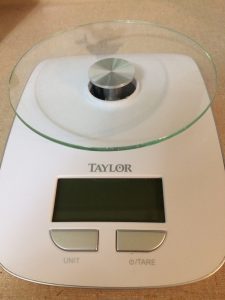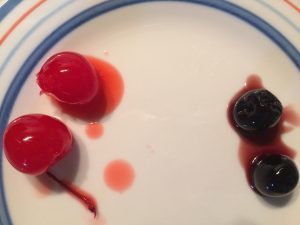Alex Gordon's Blog, page 13
December 13, 2018
Soup!
A few days ago, I bought a stalk** of celery with the intent to use it in an as yet untried recipe. Then I forgot which recipe I had intended to make, which left me with a stalk of celery hanging fire in the vegetable bin.
Well, it’s Winter, according to temperature if not the calendar, and that means comforting, warming food like soup. I looked for a recipe that didn’t call for much if any butter or cream because I think that type of creaminess overwhelms the taste of delicate vegetables like celery, and found this one on the Erren’s Kitchen website that uses white potatoes as the thickening agent. Sautéd onion and garlic, then added celery, potatoes, stock, and a teaspoon and a half of Penzey’s dried Bouquet Garni.
 Time to get cooking
Time to get cookingThe celery and potatoes cooked quickly—I checked them at the 15-minute mark, and found they were fork-tender. So I took the pot off the heat, and zapped the soup with the immersion blender. Result, two quarts of fresh-tasting soup with a thick, creamy consistency. If I wanted to add some dairy smoothness, I would’ve stirred in a dollop of plain Greek yogurt. But today,
 Freshly blended
Freshly blendedI had a bowl for lunch with a slice of warm, buttered Trader Joe’s asiago-peppercorn sourdough. A tasty, relatively light but filling, winter meal. Definitely a keeper recipe to add to the soup & stew rotation.
 Lunch!
Lunch!(**as an aside, I’ve always called a stalk of celery a “bunch.” However, apparently a whole bunch is a stalk, while what I always called a stalk is a rib.
November 26, 2018
Autumn Veggies
I’m not a vegetarian, but I do love vegetables and am always looking for new ways to cook old favorites. I’m a fan of roasted Brussels sprouts and roasted butternut squash, so when a friend posted this Pioneer Woman recipe for Beautiful Brussels Sprouts, I knew I had to give it a try.
There were a couple of new-to-me ingredients in this dish, namely pomegranates and pomegranate molasses. I had never dealt with seeding a pomegranate before, and suffice it to say things got a little messy. I found a You Tube video that showed how to cut the thing open, loosen the seeds by working the rind, then knock out said seeds by whacking the underside of the rind with a hefty implement like a wooden spoon. Unfortunately, I worked the rind a little too vigorously–it split apart, sending seeds and juice everywhere. Let’s just say the counter—and the nearby wall—got a good cleaning.
Anyway, I chopped up the veggies, and roasted away. This brings us to the pomegranate molasses. I wasn’t able to find it in stores, and didn’t have time to make any. So I used the next best option mentioned in the recipe, a syrupy balsamic vinegar that I can only find at Williams-Sonoma. Not a glaze per se, but a weighty vinegar usually used for drizzling over cheeses and fruit. It is pricey, but a little goes a very long way—I use it alone as a salad dressing, and a tablespoon is enough to flavor a fairly large salad.
I do like this recipe. It’s so colorful, a welcome addition to a fall or winter table. The sweetness of the squash and pomegranate seeds counters the occasional bitterness of the sprouts, and the flavor of the roasted onions is a perfect complement. Definitely a keeper.
Eggplant. It had been years since I’d cooked anything with it. But as I poked through the internet looking for info about pomegranate molasses, I came upon this recipe from Food & Wine for Eggplant and Lentil Stew with Pomegranate Molasses. I used green lentils instead of brown because that’s what I had in the cupboard. Since I had no molasses, I decided to use the same syrupy balsamic vinegar I used for the Beautiful Brussels Sprouts. I didn’t have fresh mint leaves, and so used 2 teaspoons dried spearmint leaves. I also decided to use some Persian Cinnamon Advieh that I received as a free sample from Raw Spice Bar. I had never heard of advieh before. Blends vary depending on region, with some being sweeter than others. I decided to use this one because it contained toasted cumin and coriander, which I love. In addition, I had used it previously to flavor some couscous, and was able to detect the lime. It’s a Persian spice blend, and the stew is Turkish, so it’s not strictly by the recipe book. But the recipe as written didn’t call for any spices, and given that I can never leave well enough alone anyway, I decided to go for it and added a heaping tablespoon.
After hunting through other eggplant recipes, I also decided to skip the partial peeling and salting step. One article noted that it was only necessary if one wanted eggplant as dry as possible for frying. Since I would be braising, and could let the stew cook down in case there was too much liquid, I didn’t see the point. So I simply cut it up and layered the eggplant with the other vegetables in a 3-quart casserole.
As you can see below, things became a little cramped. So I moved everything into a 3.5 quart skillet, which was still not quite large enough. I was, however, able to mash the cover down after a few minutes’ simmering.
Over time, everything cooked down.
By the end, the skillet was only half-filled. I let the stew simmer without a cover for a half-hour or so—the resulting broth was fragrant and delicious.
Okay, it’s not the prettiest dish in the world, but if you’re an eggplant fan, I’m pretty sure you’ll be pleased. Another keeper recipe. The advieh adds lovely cinnamon undercurrents—I am definitely going to make it a regular addition to my overflowing spice drawer.
October 14, 2018
Fruit and Nut Banana Loaf
I love banana bread. For the past few years, my go-to recipe has been this one from Simply Recipes. I like it because it’s simple and incredibly flexible–I long ago replaced the all-purpose flour with variations of whole wheat, varied the number of bananas, added everything from chopped candied ginger to chocolate chips, and ended up with a tasty loaf every time.
A few months ago, Jesse Miller, the editor at Jen Reviews, emailed me. Jen Reviews is a food/fitness/lifestyle site that among many other things posts recipes. Jesse noted my past post, and asked if I would consider trying one of their recent recipes for a Fruit and Nut Banana Loaf and, if I liked it, posting the results. I said ‘Sure!” because hey, banana bread, and also because I thought it was cool to be asked to try a new recipe.
The first issue I encountered was the fact that the recipe called for ingredients to be weighed. I had heard for years that weighing flour in particular resulted in more accurate measurement and a better outcome, but I had never bothered because dry ingredient measurements for the recipes I had used in the past were also given in cups and that’s what I was used to. This recipe, however, listed either grams or ounces.
My old kitchen scale was an inexact analog model that I didn’t trust as it would be too easy to be off an ounce or more in either direction. So I headed off the a local big box and hunted through the kitchen wares until I found a nice-looking digital scale. I picked this one because it could measure ounces, grams, or kilograms.
My spiff little digital scale
The second stumbling point arose when I read the recipe and found that it called for either raisins or glace cherries. I had raisins, but I’ve used them in banana bread before, and wanted to try something different. I had maraschino cherries, which are one step removed from glace cherries, the latter being maraschino cherries that have been further cooked in sugared syrup. But, I’m not a fan of maraschino cherries as I feel they lack in flavor. I did, however, also have Luxardo cherries, which are Maraschino cherries packed in Marasca cherry syrup. As you can see below, they are much darker than regular Maraschino cherries, and also much tastier (the syrup also makes a great dessert topping). So, I sliced up the requisite 3 ounces and set them aside.
Regular Maraschino: left
Luxardo: right
I also learned about caster sugar, which is sugar somewhere between regular granulated sugar and confectioners sugar in size. It’s common in the UK, but hard to find in the US–I had looked for it in a couple of grocery stores and came up empty. I decided to go with the unrefined cane sugar that I usually use when baking, and hoped that it wouldn’t adversely affect the final product.
Mixing the dough
In addition to needing to weigh ingredients, I encountered some other minor speed bumps. I didn’t have self-rising flour, which is all-purpose flour that already contains baking powder and salt. I have substituted whole wheat pastry or white whole wheat flours for white all-purpose for years, and have always added the other dry ingredients separately. So I weighed my Bob’s Red Mill Whole Wheat Pastry Flour, added the appropriate amounts of salt and baking powder to bump it up to self-rising, then added the rest of the dry ingredients, along with a teaspoon of cinnamon. I then creamed the butter and sugar until fluffy with my electric stand mixer (a Kitchen Aide Artisan), added the eggs, vanilla, and bananas, then folded in the dry blend and milk by hand as directed. Finally, I folded in the fruit and nuts.
The resulting batter is pictured above, a dense but moist mixture that I usually get when making quick breads. I piled the batter into the loaf pan, topped it with sliced almonds, and put it into the oven. Baking times are usually longer in my oven, so I added an extra 10 minutes for an hour total, checked for doneness with toothpicks, and wound up leaving it in for a few minutes more. I’m overly cautious when it comes to determining whether something is done or not, and actually prefer baked goods on the well-browned side. I am therefore prone to leaving cakes and cookies in the oven a little too long. That said, my loaf didn’t develop the nice cracked top that the Jen Reviews loaf did, but that was likely due to the differences in flour and sugar and general handling.
The finished product
I enjoyed this bread. I didn’t pick up much in the way of banana flavor, but that may have been because the bananas I used weren’t as ripe as they should’ve been. The orange and cherry flavors did come through, though–I shared the loaf with friends, and they agreed that the bread tasted more like a fruitcake than a classic banana bread. That said, we all really liked it.
The crumb proved dense but light, if that makes sense. Maybe ‘soft’ is a better word than ‘light.’ I understand that by changing ingredients as I did, I didn’t really make the recipe as shown and may not have provided a fair evaluation. But I almost always alter recipes even when they’re new to me, and I consider it a sign of a cook-friendly recipe if it can tolerate some flexibility and still yield a good result.
Snack time!
I enjoyed this variation on the banana bread theme, and would definitely make it again. Now that the weather is getting colder here in northern Illinois, a little holiday fruity-nutty goodness is a welcome thing.
As a side effect, I am also using my digital scale almost every day, both to weigh cooking/baking ingredients and recommended serving sizes. Boy, is that an education.
August 25, 2018
Blueberry-Peach-Chai Jam
I wasn’t expecting today to be a jam day. Too hot to use the stove, even with A/C. Too many other things to do. And even though I was almost out of last week’s batch of blueberry-Earl Grey, I didn’t want to make it again. I did have blueberries, but the only Earl Grey in the cupboards was a box of decaf teabags and I felt the flavor they imparted was too subtle.
For “too subtle,” substitute “undetectable.”
I also had a couple of peaches that were a little too close to going off. I had seen recipes for peach-blueberry pie before, so I knew the two fruits could be combined. I also had chai teabags. Stash Spice Dragon Red Chai, to be exact.
So, experiment. I followed the America’s Test Kitchen recipe from Foolproof Preserving except that I used 5 chai teabags instead of 5 Earl Grey, and added a half tablespoon more low/no sugar pectin to compensate for the additional fruit. I also added a healthy pinch of salt because I believe sweet things benefit from a little sodium chloride.
Blueberry-Peach-Chai Jam
I haven’t chilled it yet, but it’s delicious at room temp. The spices add depth and warmth. It would, I think, make a dandy tart or pie filling. The peaches add a nice side note, but the blueberries by themselves would be just fine. So would peaches, nectarines, or even plums.
I don’t think I’m going back to Earl Grey.
(Foolproof Preserving is a dandy guide to small batch preserving. Highly recommended.)
July 9, 2018
Oven Roasted Nectarine Butter
I love jam. Preserves. Butters. Jelly, not so much, but anything else in most any flavor, including the funky spicy and herbal concoctions. Blueberry-Earl Gray Tea. Strawberry-basil. Blackberry-ginger. I’ve never gone the full big-pots-of-boiling-water canning route, but I’ve made small batches that I can store in the refrigerator or freezer.

Ready to go in the oven
A few days ago, I was walking through the produce section of a local grocery big box when I decided to try and make a spread with less added sugar. Hunted through recipes on my phone, and found one for Oven-Roasted Nectarine Butter. Anything oven-roasted appeals to me, as did the fact that added sugar was an option, not a requirement. So I bought five pounds of yellow nectarines and headed home to get to work.
I sliced up the nectarines and piled them into a large glass baking dish. Broke open 10 green cardamom pods, ground the seeds, and sprinkled them over the fruit. I also added a scant half-teaspoon Kosher salt. I always add a little salt to jams and preserves–I feel it boosts the flavor and reduces the need for added sugar.
Then came the roasting–250 degrees F for as long as it took. I was a little concerned about whether the skins would remain intact or get tough, but as cooking time went on, they disintegrated.
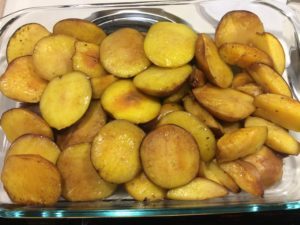
One hour
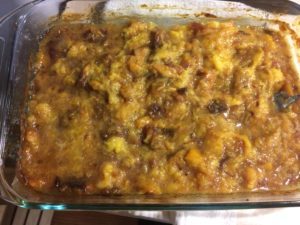
Five hours
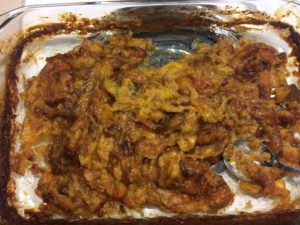
Seven hours–out of the oven
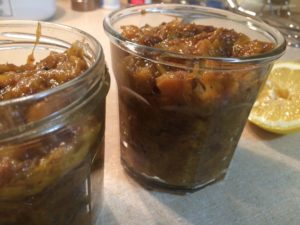
All jarred up
At the seven hour mark, the butter mounded on the spoon. Done! I added spices–a half-teaspoon of cinnamon, and quarter-teaspoons of ground ginger, allspice, and coriander. I also added the zest from half a large lemon and a couple tablespoons of juice to deepen the flavor and lower the pH. In the end, I wound up with maybe 3/4 of a liter of preserves.
It tasted good before I put it in the refrigerator, and it tasted even better the next morning. It was also very thick.
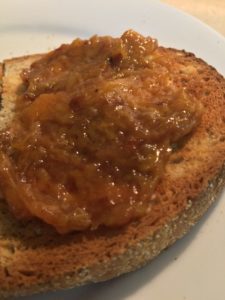
Breakfast
It’s not the prettiest stuff in the world, but it’s delicious.
I’ll definitely be making this again, with nectarines or other stone fruits. I will also try strawberries and mixed berry blends. And pears. I’m almost always disappointed in the flavor–or lack of flavor–of pear preserves, so I am looking forward to seeing if roasting improves matters.
June 25, 2018
So it’s summer
…and I’m about two waves behind in wildflower reporting.
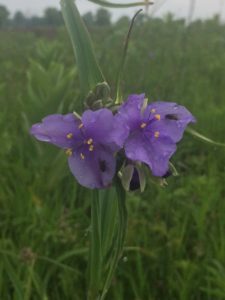
Spiderwort
The most recent burst has been the spiderwort, a not-very-attractive name for a lovely flower.

Purple, purple everywhere!

White campion

Bloomers
I’ve seen white campions for a few weeks now. I love the striped calyces. They remind me of old-fashioned bloomers.
Several of the plants I thought among the prettiest are considered invasive. They’re non-natives introduced from other continents for planting in gardens because they were attractive or, in the case of the multiflora rose, because they provided rootstock for more desirable roses. Now they compete with native plants and, in some cases, crowd them out.

Dame’s Rocket

Multiflora rose
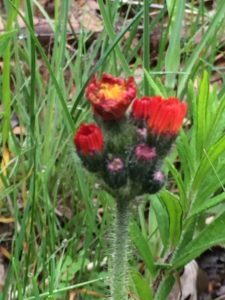
Orange harkweed, aka devil’s paintbrush
Fairly certain this is Robin’s plantain, a variety of aster. I love the faint violet blush.

Robin’s plaintain
I find the yellow salsify so striking. It’s also called oysterflower because the edible taproot supposedly tastes like oyster. Hate to type it, but it’s considered an invasive weed in some areas as well.
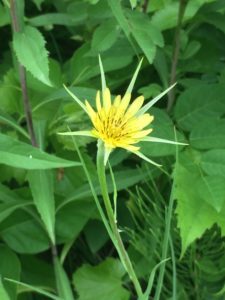
Yellow salsify
And finally, some coreopsis, which for a few short weeks seemed to be everywhere. They’re also called tickseed, which is just wrong. Given how buggy it’s been so far, I don’t need anything with “tick” in it.
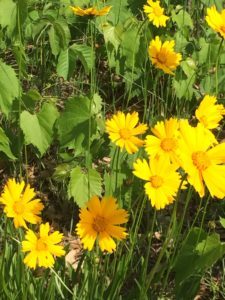
Coreopsis
I took all these photos at Illinois Beach State Park except for that of the Dame’s Rocket, which I snapped while walking along a local wooded bike trail.
Bloomers vector from depositphoto.com/Tahiku
May 20, 2018
Spring Wildflowers
As the prolonged winter chill eases in fits and starts, the wildflowers are finally starting to appear here in far NE Illinois. They started slow–a hoary puccoon here and there, dappled trout lily leaves poking up through woodland detritus–but thanks to the sun and the occasional (still!) 80+F day, they’re making themselves known.
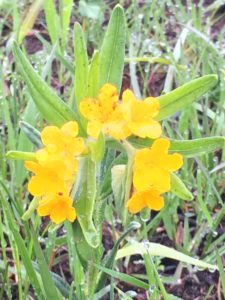
Hoary puccoon
Said hoary puccoon, short–6 inches or so–sprays of yellow and yellow-orange in the open grasslands of the state park. I’m pretty sure that the proper name for those grassy areas is “oak savanna,” but I can’t say for sure. Still at the learning stage.

White shooting star
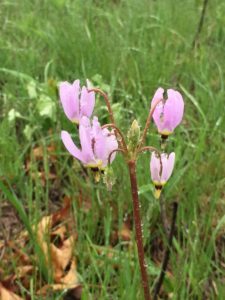
Pink shooting star
Shooting stars in the grassy areas leading into woods. The pink are more common. I was surprised to see a white one. It really stood out.

Wild lupine
Wild lupine. It’s the only plant that can host the caterpillars of Karner blue butterflies, which are on the endangered species list because of the reduction in lupine habitat.
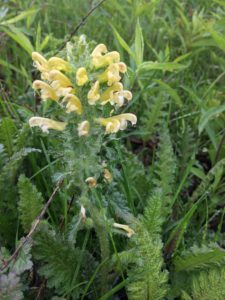
Wood betony
Wood betony, which has used in protective amulets and medicines for centuries. I encountered the pink variety more often when searching online for info, but there is a yellow variety and here it is.

Virginia bluebell
Into the woods now. I pass a clearing filled with Virginia bluebells when I walk Gaby. They’re mostly open now, making the clearing look like something out of fairy tale.

Wild geranium
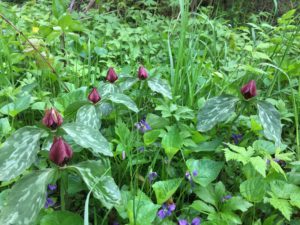
The trillium sisters
Wild geraniums are showing up, and the red trillium are finally blooming.

Wood anemone in my shady sideyard
I’m finding wood anemone in the woods now, but these particular flowers are growing in my shady sideyard, along with a few red trillium, clusters of wild violet, and Solomon’s seal (the false variety I think). I also had a boatload of trout lilies this spring, along with some clusters of marsh marigold. Ants bring in some of these seeds, and pollinate existing plants. I never realized the little suckers did that.
Spring is my season, especially the latter half. Foliage is bright, crisp green–or sometimes red, or pink–and everything is blooming. Birds are busy building nests, and baby geese swim with their parents in ponds and streams. It’s a time of fresh starts.
It’s also nice to be able to walk to the mailbox without having to bundle up. Sick and tired of boots and heavy coats.
April 12, 2018
They’re here!
My crocuses have finally opened!
Last I checked, only an inch or so of greenery had emerged. But then a mild warming trend settled in. Yesterday hit 60F, with more of the same today and tomorrow. 30s over the weekend with possible snow, which is why I’m going to leave the leaf cover in the shady sideyard until the temps moderate a little. I know there are trout lilies and other spring ephemerals there and I don’t want them to freeze.
On the other hand, I don’t want the leaf cover to smother them, either, so.
Anyway, crocuses! I love them all, but it’s nice to see the white striped ones, which seem to be multiplying. I used to see gold ones on occasion, too, but haven’t in a while. The squirrels like to dig up the bulbs and drop them elsewhere–I imagine some of the bulbs didn’t survive the move.
March 19, 2018
Naming Characters (Or, Thoughts While Grocery Shopping. And a Food Experiment)
I struggle with character names. The first name I think of is often the one on which I settle, even if I’m not all that enthusiastic about it, because I can’t develop a character unless they have a name. This doesn’t matter so much if it’s a minor character who’s there in one chapter and gone by the next. But too often I’ve had one-offs blossom into series regulars, and when that happens I usually wish I had taken more care in the choosing.
When I gave the name “Durian Ridgeway” to one of my antagonists in Code of Conduct, I did not consciously realize that I had chosen to name him after an Asian fruit renowned for its stench. I am guessing that I heard the word at some point previously, and that it stuck with me because it is a pleasing collection of syllables. It also worked well with the more clipped surname and denoted—to me, anyway—an upper class background. It wasn’t until a reader mentioned how well Ridgeway’s personality aligned with the durian’s legendary stink that I looked up information about the fruit and realized I had either made one of those serendipitous backbrain connections or stumbled headlong into the trap of one person’s perfectly good name being another’s curse word/term for a body part/pejorative.
Years passed. I never heard the durian comment from any other readers, so I didn’t think about it much—when I reissued Code in 2015, it never occurred to me to change Ridgeway’s name. I was, however, mildly curious about just how unpleasant the smell of a durian actually was. I poked around a bit online, and learned that the stink is so potent that the fruit is banned on Singapore Rapid Mass Transit. It’s also chemically complex, containing fifty compounds four of which were previously unknown. In addition:
Even apart from the smell, durians are a scientific marvel. According to a 2009 Japanese study, durian extract strongly inhibits the enzyme aldehyde dehydrogenase (ALDH), used by the liver to break down alcohol. This might account for a piece of traditional Asian folklore: that getting intoxicated while eating durians can lead to death.
Okay, then.
Earlier this month, as I steered my grocery cart down the Asian Foods aisle of the local warehouse grocery store, what to my wandering eye should appear but a durian fruit, safely confined within a refrigerator. It was huge, a deflated basketball covered with spikes.
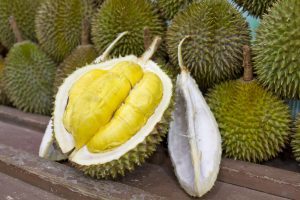
Durian (not the one in the fridge) Photo: davidgn @depositphoto.com
I did not open the refrigerator to explore further, but continued on my way, only to spot these in the cookie and cracker section:
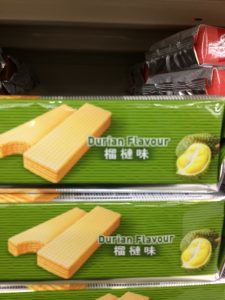
Durian wafers
This, I decided, was an opportunity to evaluate a muted version of the infamous fruit. Stinkbomb Lite. I hunted around on my phone, and found mentions of savory/sweet, garlic and fruit flavors, and decided I could take the chance.
When I got to my car, I opened the package and sniffed. Definitely detected garlic. The faintest hint of burnt rubber. A mustiness that didn’t jibe with the concept of a sweet wafer. I took a deep breath, intoned “Research,” and took a bite.
Yup, garlic, along with a bit of blue cheese and a hint of sweetness. After a minute or so, the garlic and odd savory undertones bloomed a little more. Not unpleasant, but not a flavor that would make me jump up and down and yell “Yum!” I would consider serving these things with a stronger cheese like blue or Gorgonzola. I would also keep the Altoids handy because the garlic tends to hang around.
In closing, if I had a chance to do it over, I would still probably keep Durian Ridgeway’s name as is. It really is appropriate. But next time an interesting collection of syllables pings my brain and whispers ‘wouldn’t I make the best name,’ I will look it up first.
January 11, 2018
Winter flowers
Happy New Year!
I’m only a little late.
If you’ve followed my (admittedly infrequent) blog posts, you’ll have figured out that I enjoy gardening and love flowers. That means it’s a pretty grim situation now and for the next few months as winter has settled in for the long stretch between the holidays and that hell known as Spring Mud Season. The lawns still show a little green and the evergreens are as ever, but deciduous trees appear lifeless and the shrubs are stripped and sad-looking.
Lucky for me, I have some indoor flowers to brighten things up.
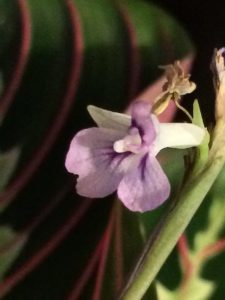
Prayer plant flower
The prayer plant is known mostly for its colorful leaves–note the red veins and light green feathering down the middle of the background leaves–and it’s not a prodigious bloomer. One article I read referred to the flowers as “insignificant.” I beg to differ. They are only a half inch or so long, but they remind me of tiny orchids and I love them.

African violets
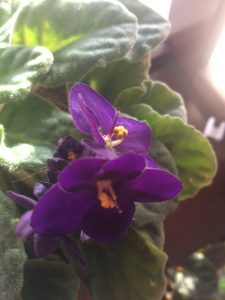
Another violet
My African violets are blooming again after having slowed down a bit over the fall. Like most of my other indoor plants, they’re on a ladder shelf by the south-facing backdoor, the site of the best light in the house.

kalanchoe, pronounced ka-lun-KOH-ee
Finally, there’s the kalanchoe–I always pronounced it kuh-lan-cho until I learned differently this very day–a succulent that supposedly thrives under conditions of “benign neglect.” I planted it in a very loose blend of perlite and vermiculite and water infrequently, and it has taken off flower-wise after having rested over the summer and fall. It’s loaded with bud clusters, some of which have just started to open.
So that’s it. Just enough color to tide me over until the temperatures warm and we have daylight after 5pm. I took a little kalanchoe shoot and am trying to start it in another pot–so far, so good I think. I mean, it’s still green. I have an indoor palm that seems to be happy, a schefflera that I had to cut back before it took over the dining room, and heartleaf philodendra everywhere.
But I do love my flowers.
Alex Gordon's Blog
- Alex Gordon's profile
- 135 followers







